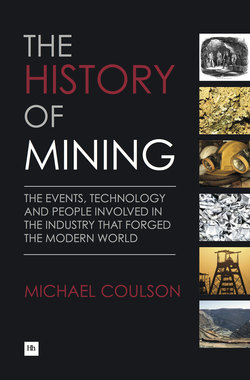Читать книгу The History of Mining - Michael Coulson - Страница 36
На сайте Литреса книга снята с продажи.
Оглавление4. France
With the ending of the Dark Ages, France, no longer under the thrall of Rome, began to recover and as a result a number of iron-based industries emerged, including weapons, armour and wrought work. By the 12th century coal had been discovered and began to be mined in the region east and west of Liege, where coal mining continued well into the 20th century.
One of France’s oldest mines was the Salsigne gold mine near Carcassonne in the southwest. The mine was first exploited by the Romans in the 3rd century, but as an iron mine. The furnaces were fired by charcoal and wind tunnels were used to power them, another example of Roman technology anticipating the modern world. The Romans, however, did not realise that there was gold in the slag that was discarded in the iron-making process, perhaps as much as 1 million ozs, and now lost forever under the town which was eventually built on the mine dumps. During the Middle Ages Salsigne was mined intermittently for its iron ore, but it was only after a period as an arsenic or arsenopyrite mine at the end of the 19th century that gold was finally discovered, and during the 20th century 100 tonnes of gold and 300 tonnes of silver were produced at Salsigne.
By the time of the Middle Ages mining had begun to expand in Europe, with the negative influence of the Dark Ages on social and economic activity beginning to wane. The old silver and copper mines of Aveyron in south central France were re-opened in the 10th century and were worked for some centuries following. The main target for this revival of mining activity in France was silver, which was increasingly in demand for coin as commerce began to revive. Other areas that saw a surge in mining were Lorraine in the northeast, the Auvergne in the centre of the country, and the Pyrenees, where silver and gold were the main metals sought.
In the 14th century the lead and silver mines in the Languedoc in the southeast at La Caunette were re-opened and to the northwest in the Cevennes alluvial gold was mined in the region’s river courses. Mines in the Pyrenees had been worked intermittently for centuries for lead and silver by both the Romans and the Moors, and in the early 17th century under Henry IV of Navarre mining resumed at these ancient sites also. It is believed that the mines provided huge profits for both the King and his brother who oversaw the mining operations.
Mining has never been a natural activity for the French, who are far more comfortable with the agrarian way of life, and in the 13th and 14th centuries the mines found themselves the target of rising rental claims from the landowning nobles who were often at odds with one another, inserting another layer of uncertainty for the mines. The mines also had to battle against rising operating and labour costs, the latter being particularly affected by an end to the system of forced labour.
The Paris Basin
Perhaps in hindsight one of the strangest mining areas in Europe was the Paris Basin, where a considerable number of mines were developed in the Middle Ages in the area of what is now substantially the city of Paris. The minerals won from these mines were not the glamorous ones of gold, silver and copper but were industrial minerals such as gypsum and building stone for Paris’s expansion. Indeed, it is the gypsum deposits of Montmartre that gave the name to the well known product plaster of Paris, and mining of that gypsum was first recorded in the late 14th century. In the 13th and 14th centuries stone quarries were developed well away from the old city centre and they were often accessed by digging a large shaft down and then mining the stone horizontally. This continued until the 15th century when the city began to expand towards these previously mined and now forgotten areas.
As the decades went by major buildings such as the Observatory and the Val de Grace church in the south of Paris were built on top of the old quarries and mines, as were a number of roads going south towards Fontainebleau and Versailles. In time cave-ins occurred, sometimes with considerable loss of life, and in the end the City had to survey the old mine workings, map them and secure them. The underground mines of Paris are sometimes referred to as the Catacombs, and though most of them are legally off limits today not everyone pays attention; unofficial visitors to them are known as cataphiles.
